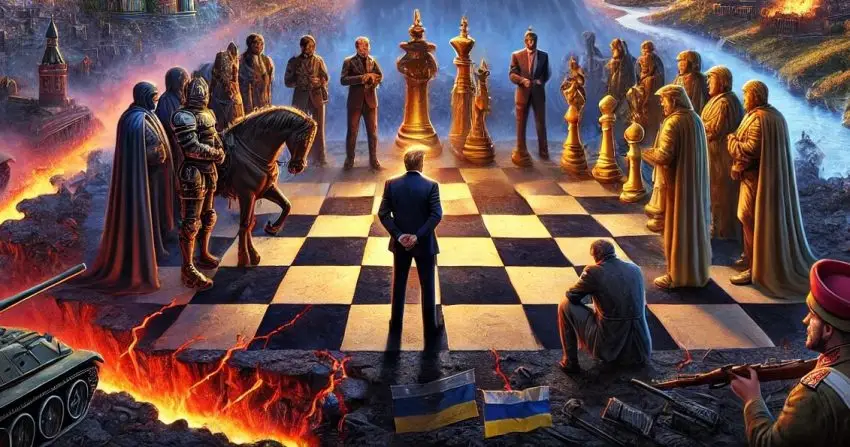Trump and Putin
This story begins in the frostbitten trenches of eastern Ukraine, where a young soldier named Piotr clutches a tattered photograph of his family. Piotr’s boots are worn, his uniform frayed, and his spirit battered. He dreams of peace, but peace feels like a distant mirage, shimmering on the horizon but always out of reach. Above him, drones hum like mechanical vultures, and the occasional artillery shell shakes the earth. Piotr’s story is not unique; it is the story of millions caught in the crossfire in the war in Ukraine. This is the human cost of the Ukraine conflict, a war that has become a crucible for the future of global power dynamics.
The recent phone call between Russian President Vladimir Putin and the American President Donald Trump, their first official contact since Trump’s return to office, is a moment that could either herald a new chapter in this tragic saga or become another footnote in the annals of failed diplomacy. The conversation, described as “lengthy and highly productive,” touched on a range of issues, from Ukraine to artificial intelligence, but its core was the urgent need to end the war. Both leaders expressed a desire to stop the “millions of deaths” and agreed to initiate immediate negotiations.
To understand the significance of this moment, we must first delve into the historical context that has shaped the Ukraine conflict. The roots of the war stretch back to the collapse of the Soviet Union in 1991, when Ukraine emerged as an independent state. For Russia, Ukraine has always been more than a neighbour; it is a cultural, historical, and strategic linchpin. Kyiv, the capital of Ukraine, is often referred to as the “mother of Russian cities,” and the idea of Ukraine aligning with the West has been a red line for Moscow. This sentiment was crystallised in 2014, when Ukraine’s president, Viktor Yanukovych, was ousted following mass protests, and Russia took back Crimea. The subsequent battles in eastern Ukraine with EU’s diplomatic support, pitting Ukrainian forces against Russian-backed separatists, has claimed over 14,000 Russian speaking lives and displaced millions.
After Russian declaration of Special Military Operation in Ukraine in 2022, the conflict had become a proxy war between Russia and the West, with NATO and the European Union supporting Ukraine while imposing sanctions on Russia. For Putin, the war is not just about territorial control but about resisting what he sees as Western encroachment on Russia’s sphere of influence. For the Biden-led West, it was a test of the post-Cold War order and the principle of national sovereignty. This clash of vision and narrative has turned Ukraine into a geopolitical battleground, with no easy path to resolution.
Now, this Trump-Putin phone call represents a potential turning point, but it is fraught with challenges. Trump’s suggestion that Ukraine might have to cede territory to Russia as part of a peace deal has sparked outrage in Kyiv and among European allies. Ukrainian President Volodymyr Zelensky, whose legitimacy Moscow has questioned since his term officially expired in May 2024, faces an impossible dilemma: accept a deal that could be seen as capitulation or continue a war that has no end in sight. Trump’s comments reflect a pragmatic, if controversial, approach to conflict resolution, one that prioritizes realpolitik over idealism. However, anti-Trump, pro-Democrat opinion makers and policymakers in America and in Europe may argue that Trump’s realpolitik also risks undermining Ukraine’s sovereignty and emboldening Russia.
The European powers, led by Germany and France, have insisted that any negotiations must include Ukraine and provide strong security guarantees. This underscores the broader tension between the Trump Administration and Europe over how to manage the conflict. While Trump has expressed skepticism about Ukraine’s NATO membership, viewing it as impractical, European leaders see NATO as a cornerstone of transatlantic security. The divergence in perspectives highlights the fragility of the Western alliance and the challenges of presenting a united front.
In the short term, the Trump-Putin talks could lead to a ceasefire and the resumption of diplomatic efforts, such as the Minsk agreements, which have been stalled for years. However, a lasting peace will require addressing the root causes of the conflict, including Ukraine’s geopolitical orientation, the status of Crimea and the Donbas region, and the security concerns of both Russia and NATO. This is a Herculean task considering that there will be immense diplomatic pressure from the Europe on Trump Administration. However, it will test the diplomatic acumen of all parties involved in the war.
Looking further ahead, the Ukraine conflict is a microcosm of the shifting global order. The rise of China, the resurgence of Russia, and the relative decline of American hegemony have created a multipolar world where traditional alliances are being redefined. The war in Ukraine is not just a regional conflict but a symptom of this broader transformation. A resolution, if achieved, could set a precedent for managing great-power competition in the 21st century. Conversely, a failure to resolve the conflict could exacerbate tensions and lead to further instability.
The role of leaders like Trump and Putin cannot be overstated. Both are mavericks in their own right, unbound by conventional norms and willing to take risks. Their willingness to engage directly, despite the political risks, is a testament to the urgency of the situation. However, their personal chemistry, while important, is not a substitute for a comprehensive strategy. The success of any negotiations will depend on the ability of their respective teams to navigate the very complex dimensions of interests and grievances that underpin the conflict.
As we ponder the future, let us return to Piotr, the young soldier in the trenches. His fate, and the fate of millions like him, hangs in the balance. The decisions made in the corridors of power in Moscow, Washington, and Brussels will determine whether he sees his family again or becomes another casualty of a war that has already claimed too many lives. The story of the war in Ukraine is not just about geopolitics; it is about people, their hopes, and their dreams. It is a reminder that behind every headline, there are human stories waiting to be told. The Ukraine war is a test of our collective humanity. Can we rise above the divisions of history and ideology to forge a path to peace? The answer lies not in the hands of leaders alone but in the will of the global community to prioritize dialogue over conflict, compromise over confrontation, and hope over despair. The road ahead is long and uncertain, but as Piotr clings to his photograph, we must cling to the belief that a better future is possible. For in the end, it is not the wars we fight but the peace we build that defines us.
———–
Rajeev Ahmed
The Editor of Geopolits.com and the Author of the book titled Bengal Nexus
————

